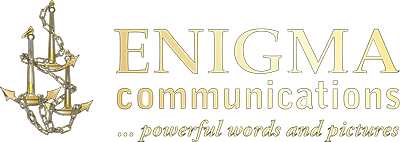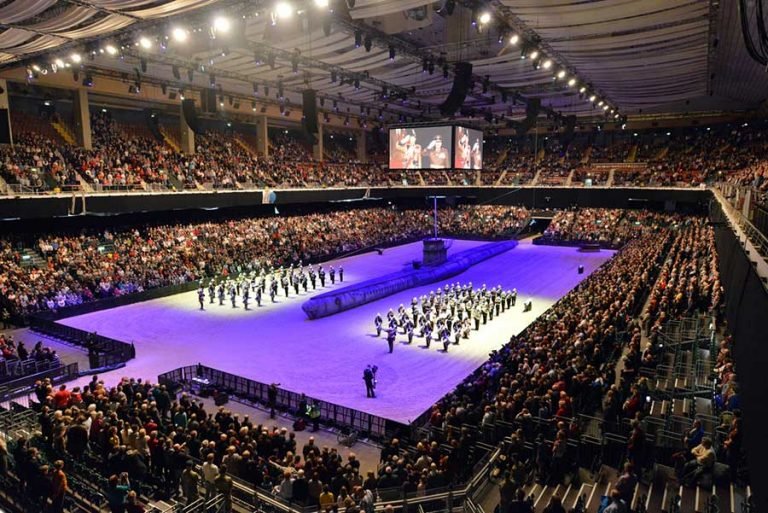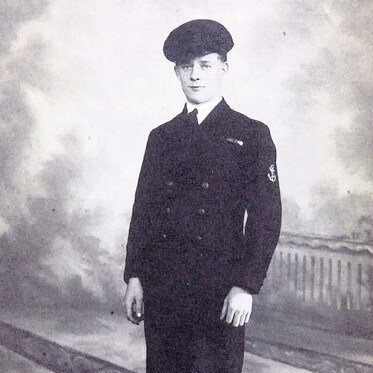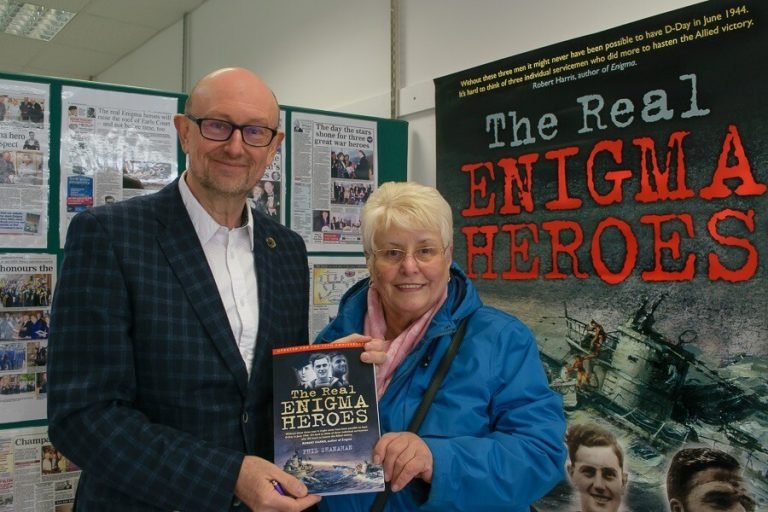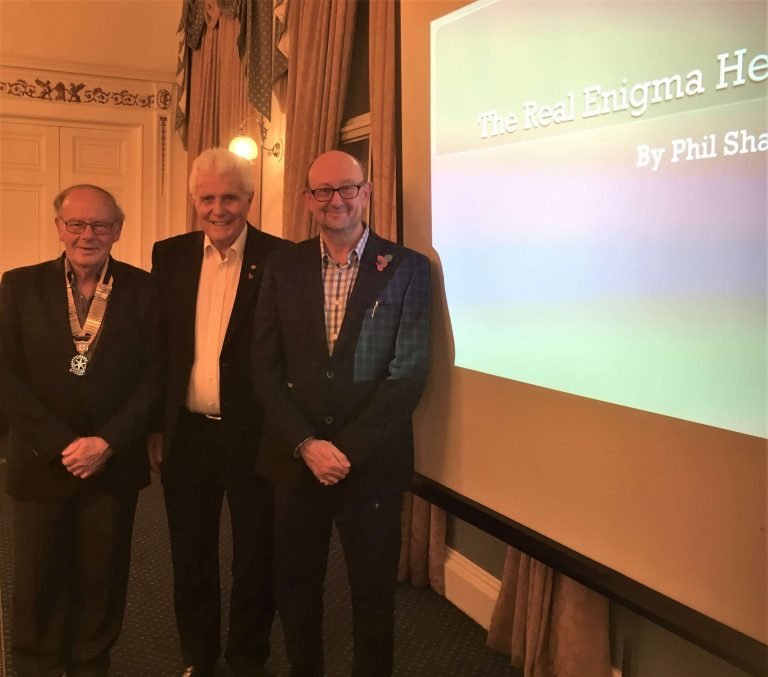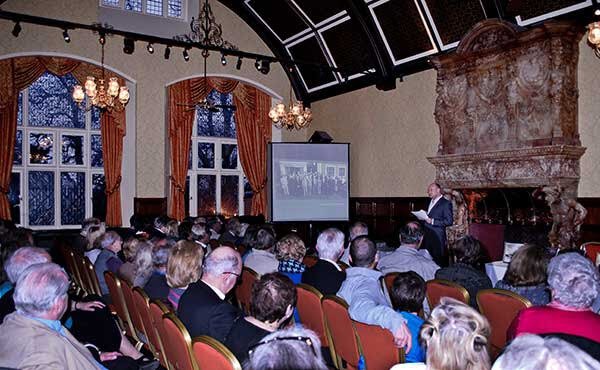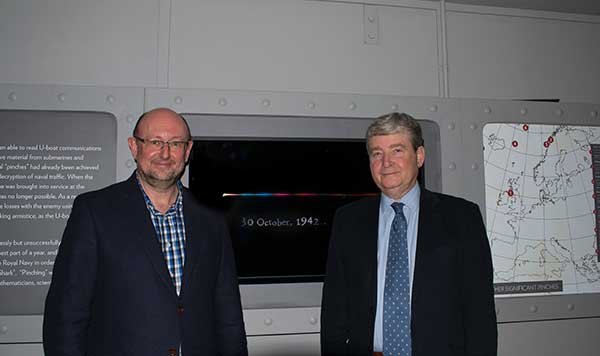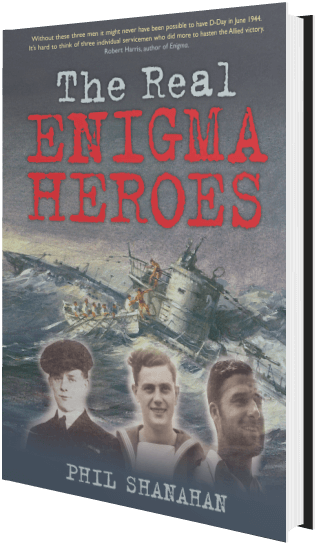New ebook of The Real Enigma Heroes marks 75th anniversary of pivotal WW2 action
An ebook and updated version of The Real Enigma Heroes by Enigma Communications managing director Phil Shanahan has been published to mark the 75th anniversary of the WW2 story that inspired it.
On October 30, 1942, two Royal Navy men serving on HMS Petard drowned whilst retrieving codebooks from a German U-boat. A teenager, who helped them, also lost his life tragically two years later.
Able Seaman Colin Grazier, from Tamworth in Staffordshire, was 22 and had been married for just two days before he set out to join the British destroyer. First Lieutenant Tony Fasson, from Jedburgh in Scotland, was 29. The Enigma material they seized from the U-559 enabled Alan Turing and his team of brilliant codebreakers at Bletchley Park to crack the German naval Enigma code and pave the way for peace.
For decades after the war the Navy men’s heroism remained shrouded in secrecy for fear the Germans would find out their ‘unbreakable’ Enigma code had been compromised.
Phil led a campaign, launched in 1998, to bring the story to public attention while working as a newspaper editor in Grazier’s home town.
The fight to honour Grazier, Fasson and Tommy Brown, a 16-year-old NAAFI canteen assistant on board the Petard, was to last for years. Along the way the author clashed with Hollywood, met members of the Royal family and discovered Prince Charles has a personal connection with the story.
Phil Shanahan describes the story ‘like something straight out of a boy’s adventure comic.’
The Real Enigma Heroes is packed with eyewitness accounts from the crew of HMS Petard which had forced the U-559 to the surface after bombarding it with depth charges. They were old men when they discovered the true significance of the action.
The codebooks seized from the U-boat included the Short Signal Book and the Short Weather Cipher which provided priceless material for the Allies.
It meant the messages used by the German high command to communicate with their U-boat fleet out in the Atlantic could now be read. Intelligence gained from the deciphered communications was codenamed Ultra and revealed the positions of the submarines. As a result, convoys bringing essential supplies, including food, to Britain from America could be re-routed to avoid attack.
Britain had narrowly averted being starved into surrender and could prepare for the land battles ahead, which came to a head with the D-day landings.
The author says the men’s sacrifice should never be forgotten. According to shipmates, Fasson and Grazier stripped naked and swam out to the crippled U-559. In doing so, they headed for the very hell their enemy was fleeing.
They boarded the submarine together and began to smash open cabinets with their guns. They passed the contents, including the codebooks, up to Brown who had joined a boarding party making its way to the vessel on a small boat.
Both Fasson and Grazier went down with the U-boat when it took in a sudden rush of water. Their bodies were never recovered.
Brown had managed to pass the books up to his colleagues. As the submarine sank he popped out of the conning tower like a cork and survived, only to die later in a house fire, along with his younger sister.
Thanks to the documents the men got from the U-559, the code (known as Shark) was solved at Bletchley Park on December 13, 1942.
Within one hour of the breakthrough 15 U-boat positions were identified. Reading Shark saved an estimated 500–750, 000 tons of shipping in the following December and January alone.
Fasson and Grazier were posthumously awarded the George Cross. Brown received the George Medal. However, the need for secrecy condemned the men to anonymity. Not even their own families could be told details of what they had achieved.
“It started off as a purely local story and campaign for Colin Grazier to raise money for some sort of memorial to him in Tamworth, but we soon saw it was much bigger than that and found ourselves carrying the torch for Fasson and Brown too,” said Phil.
The culmination of the campaign was the unveiling of the three-anchors monument in St Editha’s Square, Tamworth. The memorial was created by world-renowned sculptor Walenty Pytel, who produced the Queen’s Jubilee fountain sculpture at the Houses of Parliament. The Enigma heroes sculpture features a genuine ship’s anchor weighing more than two tonnes. Each anchor represents one of the men’s lives.
Many other tributes came about as a result of the campaign. In Tamworth there is now a Colin Grazier hotel and roads have been named after each of the men, Bletchley Park, HMS Petard and even the ship’s captain, Mark Thornton. Beers have also been named after the heroes and last year Phil helped to script a short film about the story at Bletchley Park.
During the campaign Hollywood released a film which made out the real Enigma heroes were fictional American sailors.
“I had a public spat with Jonathan Mostow, the director of U-571,” said Phil. “Our exchange of letters made headlines in the media both here and in the USA. The profile of the campaign went crazy after that.”
![]() In 2008, Phil was invited to present his book to Prince Charles and the Duchess of Cornwall at Bletchley Park. He was also given the Freedom of Bletchley Park for his work on the story and had the honour of opening Hut 8 to the public at Bletchley, where Turing and his team broke the code.
In 2008, Phil was invited to present his book to Prince Charles and the Duchess of Cornwall at Bletchley Park. He was also given the Freedom of Bletchley Park for his work on the story and had the honour of opening Hut 8 to the public at Bletchley, where Turing and his team broke the code.
The updated print version of The Real Enigma Heroes and the accompanying ebook contains some new material, including Prince Charles’ personal connection to the lieutenant, who took over from Fasson, and a dramatic re-enactment of the incident at the British Military Tournament at Earls Court in 2013.
- The updated version of The Real Enigma Heroes is published by The History Press, price £16.99. The ebook is priced at £9.99. Both feature a cover specially designed for the 75th anniversary.
